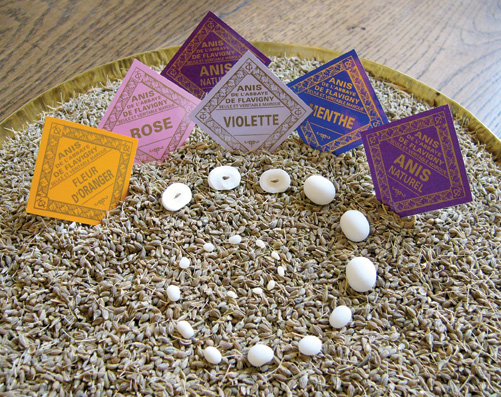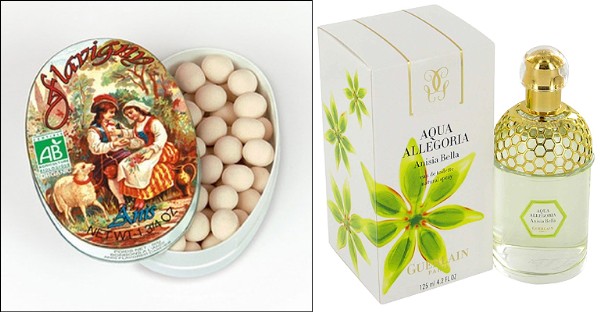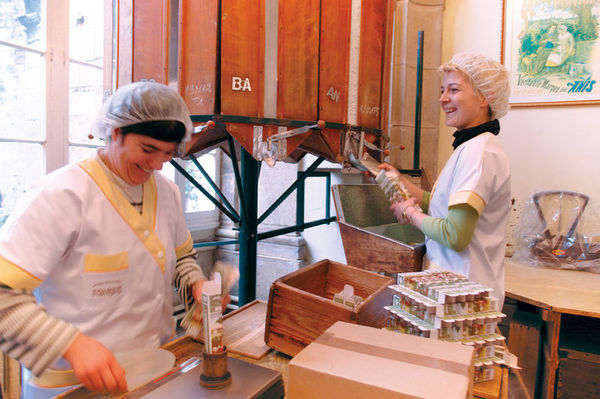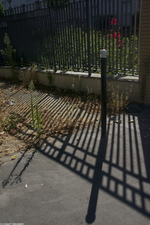Perfumes & Candies are Kissing Cousins: Anis de Flavigny & Guerlain Anisia Bella {Scented Thoughts} {Fragrant Recipes & Taste Notes}
 One of the pleasures of exploring the world of fragrances is to see the bridges that have been purposefully or accidentally built between scents meant for the nose, and those scents meant for the mouth. One thing you might have noticed is how perfumers relish taking inspiration from treats bought at the candy store in their effort to trigger fond, comforting memories of the past or to find an unconventional accord where it would be least expected to be. But they also simply often use candy descriptors in their vocabulary efforts to translate a scent into words.
One of the pleasures of exploring the world of fragrances is to see the bridges that have been purposefully or accidentally built between scents meant for the nose, and those scents meant for the mouth. One thing you might have noticed is how perfumers relish taking inspiration from treats bought at the candy store in their effort to trigger fond, comforting memories of the past or to find an unconventional accord where it would be least expected to be. But they also simply often use candy descriptors in their vocabulary efforts to translate a scent into words.
A synthetic molecule called "Carensac", part of the palette of the contemporary perfumer, is even directly named after a treat popular in French sweets culture, which combines the aromas of dark licorice and vanilla...
Perfumer Olivier Cresp of Firmenich however preferred to use Nature Print technology to capture the scent of Car-en-Sac candies for Nina Ricci Nina L'Elixir. He sent them to Geneva and then recreated the aroma with benzoin, vanilla and Lactone. Firmenich is also known for its Analysis of Flavors in Real Time (AFFIRM) which enables them to identify the molecules which reach the nose during an eating session. He then made it greener and "intriguing" in his composition, according to my notes then. He thinks that even though candied notes are suggestive of childhood and are comforting for that reason, they can be appreciated by everyone at all ages. His creation Angel by Thierry Mugler, an international bestseller, inspired by delicious goodies typically sold at Christmas fairs in the Alsace region during winter, proves him right.
This is to say that while candied notes may appear trite on the face of it, just good enough for teenagers at most, perfumery actually makes them feel quite sophisticated. Connoisseurs of perfumes ought to know their candies, it is our contention. For instance, we're not sure Jean-Claude Ellena used Carensac in his Hermès Hermessence Brin de Réglisse but it smells quite like it. The perfumer occasionally admits taking inspiration from gourmand notes. Exploring his scents reveals the depth of this source of inspiration. There is always something a bit edible or drinkable in his perfumes. So that purchasing a bag of Car-en-Sac, the candy, would allow you to tease the accord out of the composition, identify the reference and then eat it.
But the candy store in and of itself is a whole universe which is worth discovering more in detail as often candies have a long cultural and gourmet history behind them. We will visit a famous candy store in Paris to illustrate that point.
In this series, we'll bring together candies and perfumes so that connoisseurs can play both with their noses and tastebuds and cultivate additional pleasures. Perfume is really also about culture. It is not just a style accessory.
 I'm starting with the perfume that made me think of the idea for this series. Spraying on Anisia Bella by Guerlain the other day felt like smelling the famous historical candy Anis de Flavigny.
I'm starting with the perfume that made me think of the idea for this series. Spraying on Anisia Bella by Guerlain the other day felt like smelling the famous historical candy Anis de Flavigny.
There is quite a fascinating history behind that bonbon. It was originally created by Benedictin monks at the Abbaye de Flavigny in the Middle Ages, in 719. Louis XIV is said to have carried a box of it in his pocket as a matter of habit. After the French Revolution, the original recipe was reportedly reappropriated by 8 confectioners, all from Flavigny. In 1821, it is called Anis de Flavigny ou de Verdun as there was a competition between the two locales. Today, since 1923, Maison Troubat, operates within the premises of the Abbey de Flavigny, and goes on making this herbal candy containing a real green aniseed in its core (Pimpinella Anisum) also known under the name "musky aniseed" to show once more that perfumery and candies are kissing cousins.
Today there are organically certified Flavigny Anises which you can recognize thanks to its green label but also thanks to the color of the sweet which is browner, as it uses brown sugar cane. The "normal" kind uses white beet sugar and therefore is more snow-white in coloring.
 The Anis of Flavigny is a dragée confection in which the almond is replaced by aniseed. It takes two weeks for the confectioner to turn a green aniseed of 2 mg into a 1 g candy. Le confiseur moderne ou l'art du confiseur et du distillateur (1821) writes that the end-result should be the size of a cherry pit. Today, size matters as ever and it is one of the characteristics which gets rigorously controlled. In the past, it is said that it could take up to 6 months to attain this ideal size. There exists a range of dainty flavouring nowadays, including violet, orange blossom, rose, cassis, lemon and more.
The Anis of Flavigny is a dragée confection in which the almond is replaced by aniseed. It takes two weeks for the confectioner to turn a green aniseed of 2 mg into a 1 g candy. Le confiseur moderne ou l'art du confiseur et du distillateur (1821) writes that the end-result should be the size of a cherry pit. Today, size matters as ever and it is one of the characteristics which gets rigorously controlled. In the past, it is said that it could take up to 6 months to attain this ideal size. There exists a range of dainty flavouring nowadays, including violet, orange blossom, rose, cassis, lemon and more.
Why is aniseed such a good plant to have its own candy? The monks would have known its digestive properties. It is also known to have an oestrogen-like effect which makes it a good ally for women wanting to get relief during their periods and also during menopause against hot flashes. It can help with lactation too. In 1910, a French source described Anis de Flavigny as "a very wholesome candy, very much appreciated by mothers".
While Anisia Bella by Guerlain (2004) in the fresh Aqua Allegoria collection features star anise rather than green aniseed, its green hebal burst, with basil, allied with a sweet facet is reminiscent of the intensity of the green aniseed flavour softened by sugar that Anis de Flavigny is reputed for.
Top & 3rd pictures: Wikipedia
2nd picture: Flavigny; Guerlain
Warning: sugar should be consumed with moderation. Try sprizting a sugary perfume instead.








